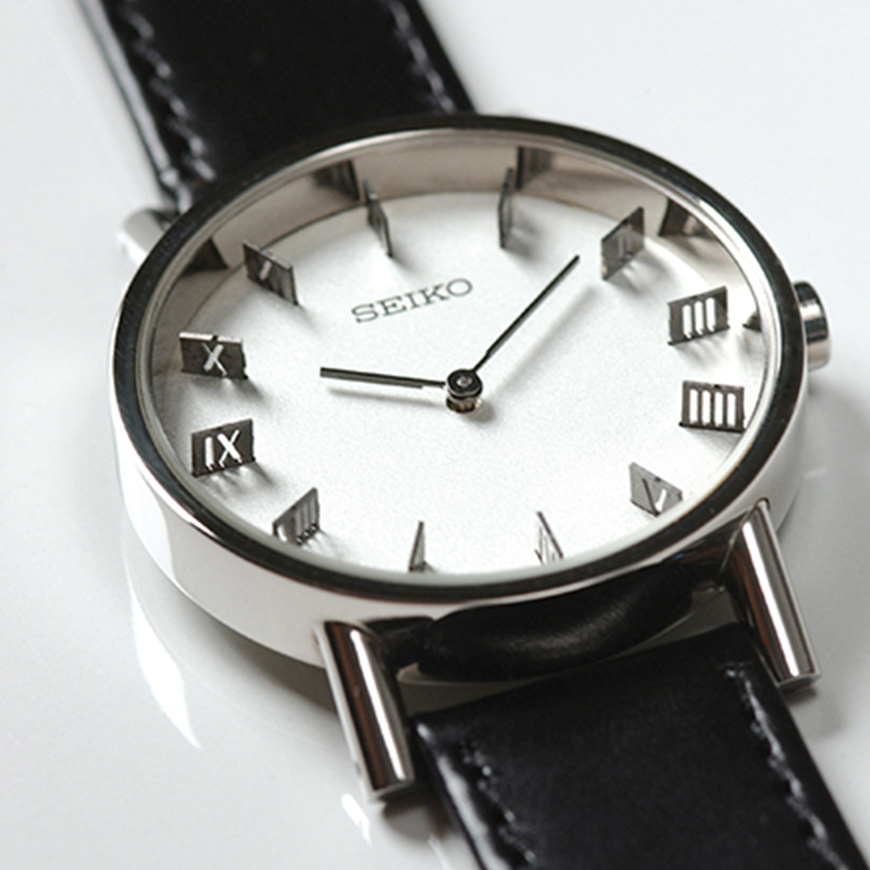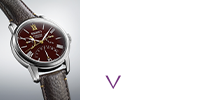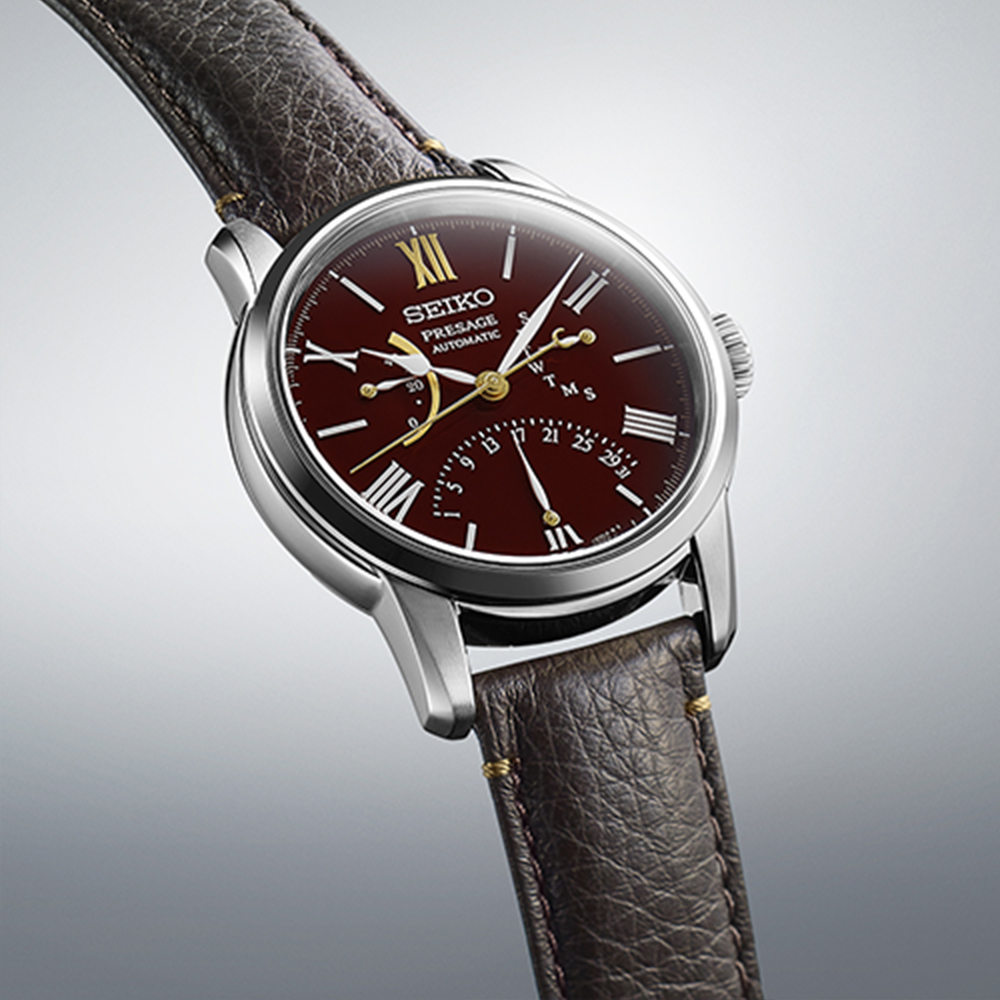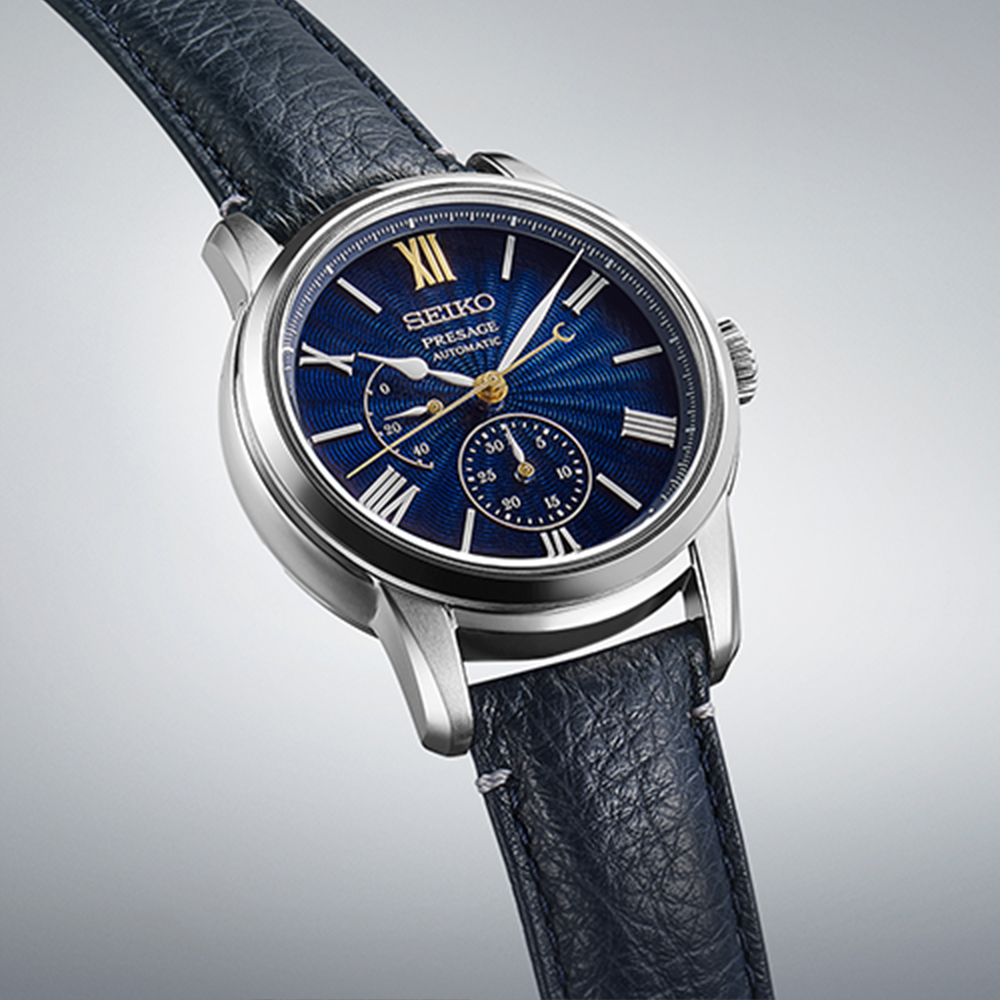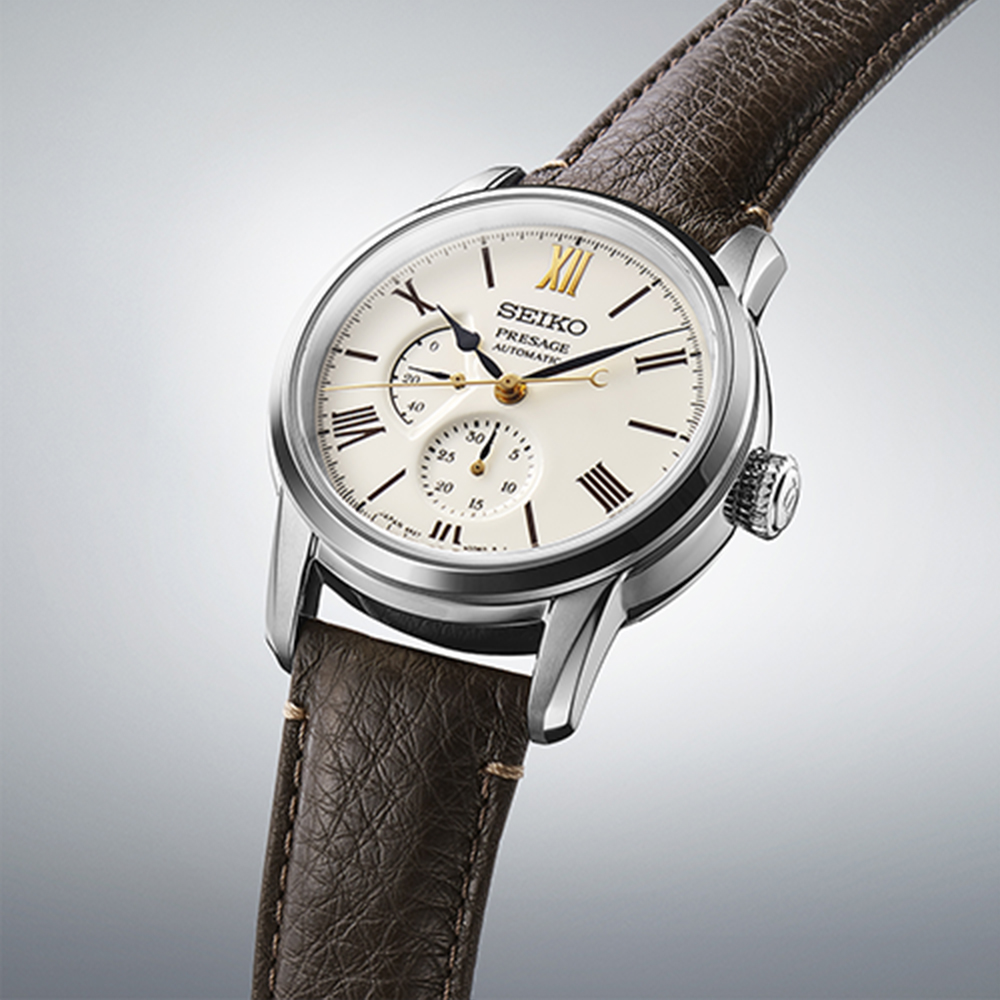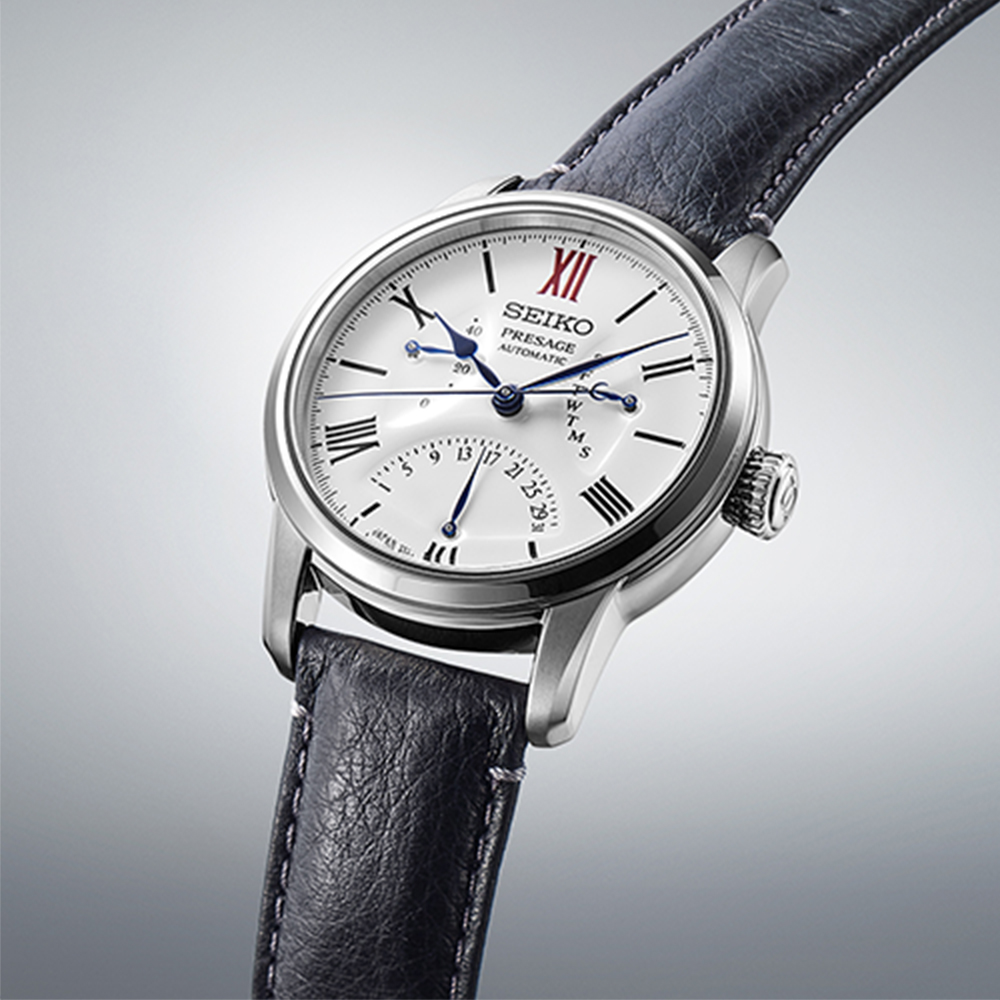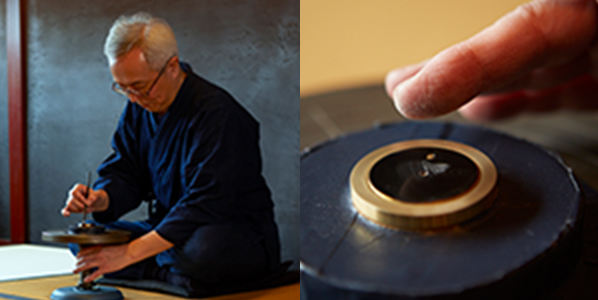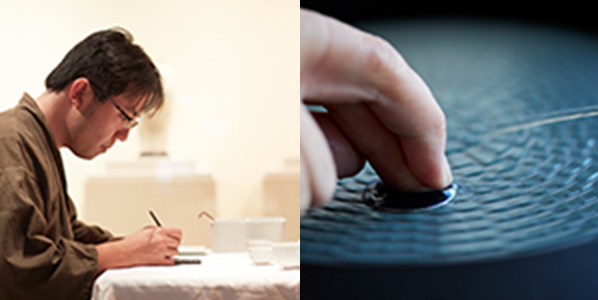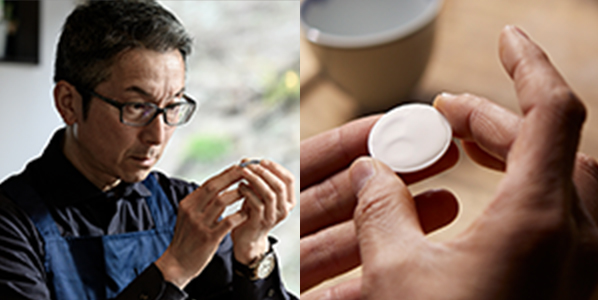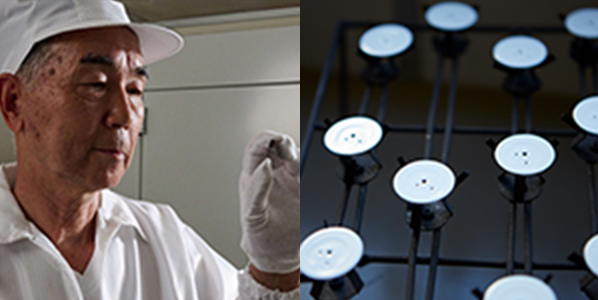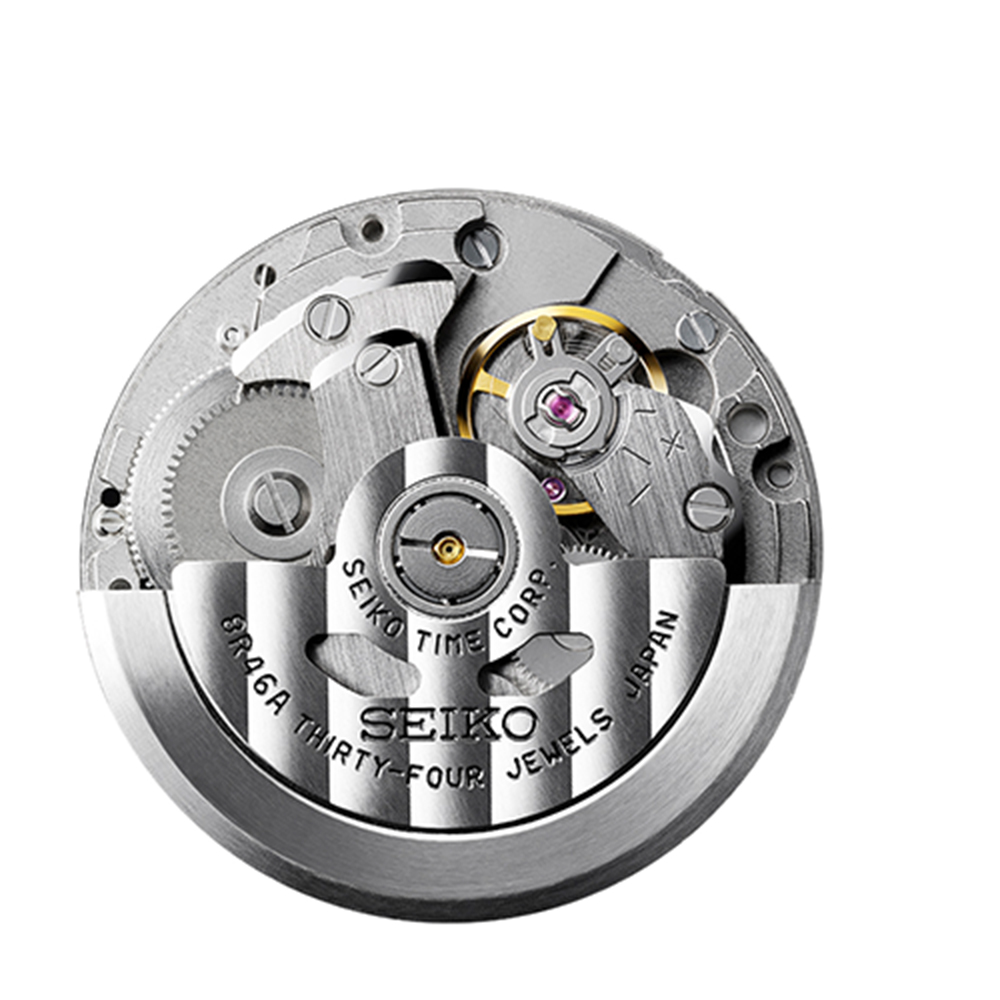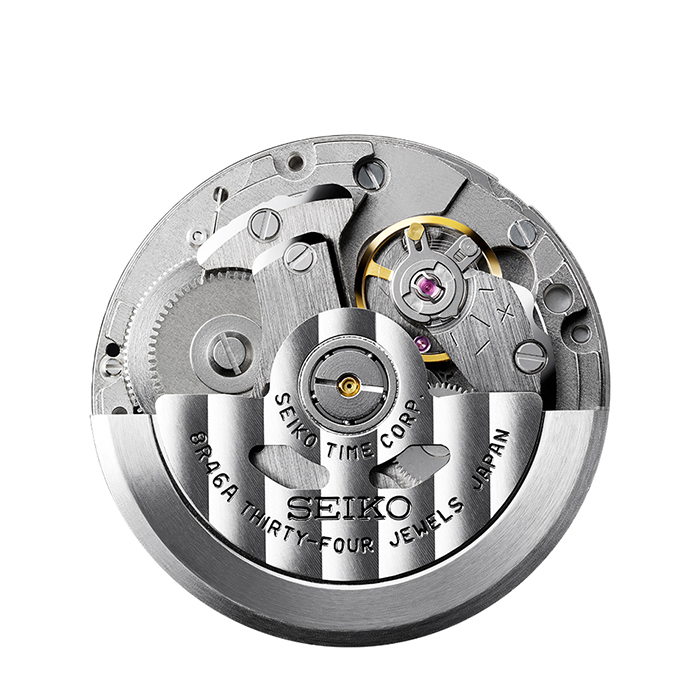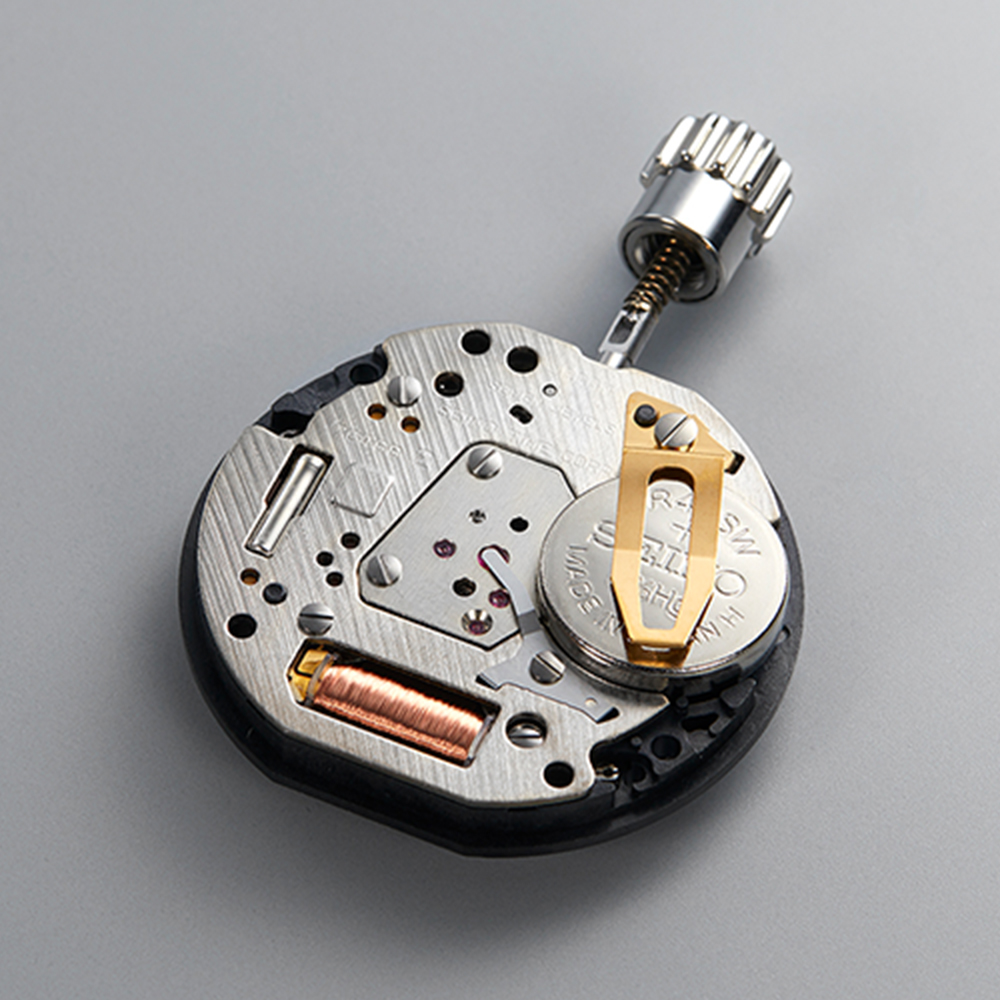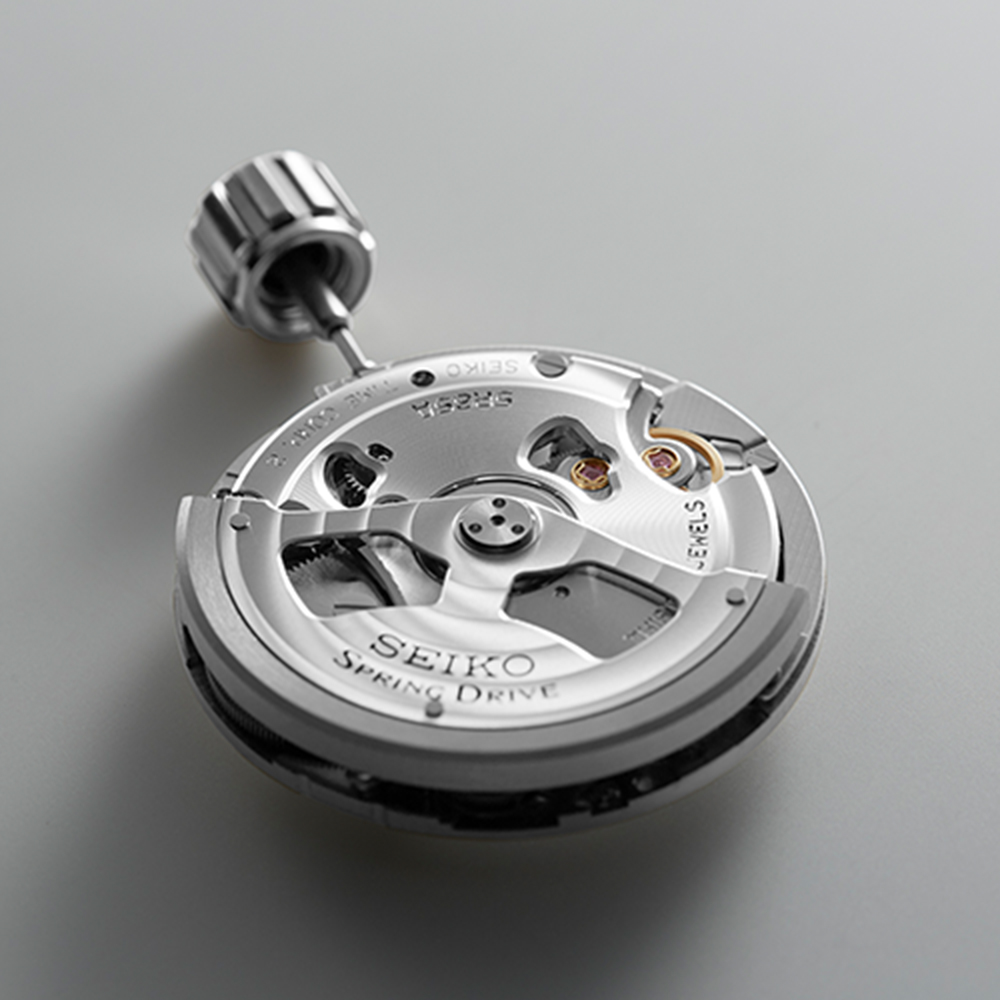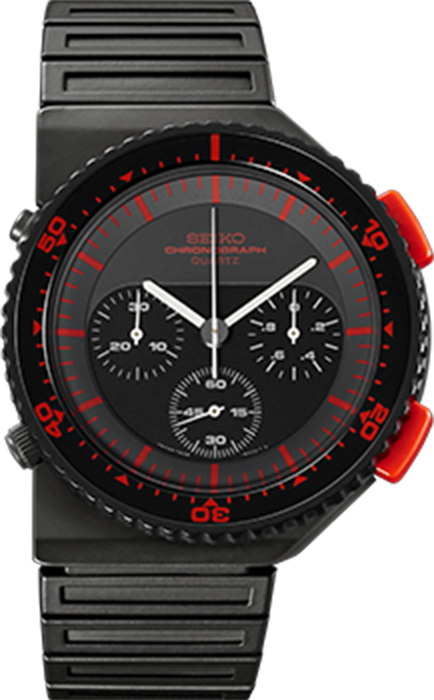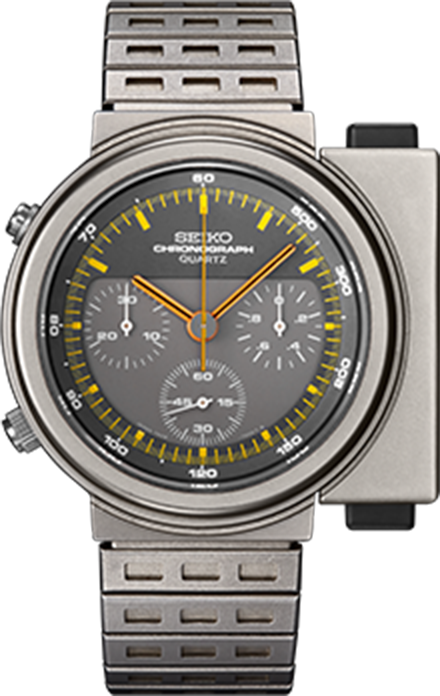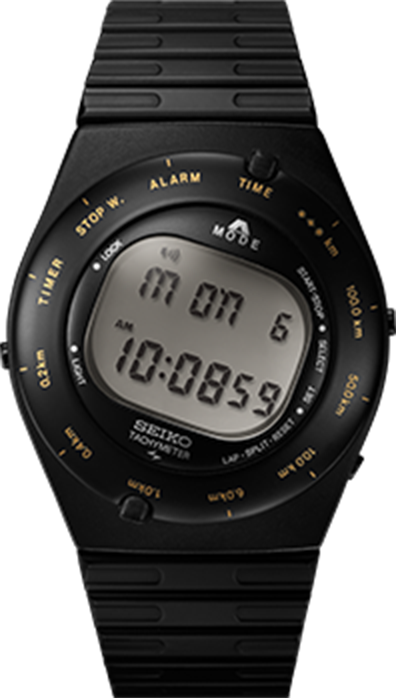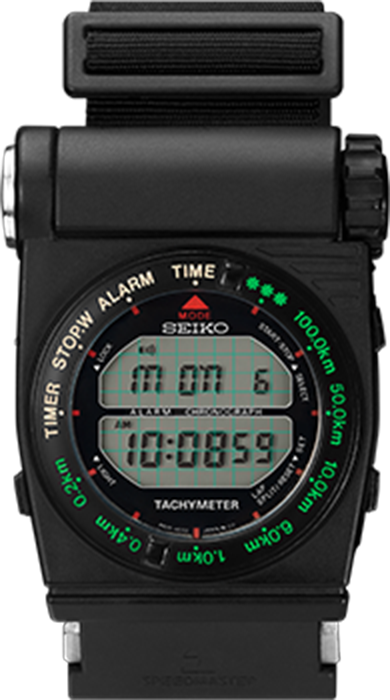Elegant Watches:
The Pursuit of BeautyLadies Watches
On the one hand, watches are tools for telling time, but on the other, they can also be a decorative accessory for both men and women. From early on, Seiko offered highly decorative watches, such as ring and pendant watches, for women. Of course, the same characteristics that made them popular were also offered in traditional wristwatches. In Seiko’s archive of watches are many women’s models that feel just as fresh and appealing today as they did back then.
For example, when the White was launched in 1964, leather watch straps were common. This model, which unified the case, dial, and bracelet in silver-white and combined this with a delicate design, became a popular item for many.
42
WHITE
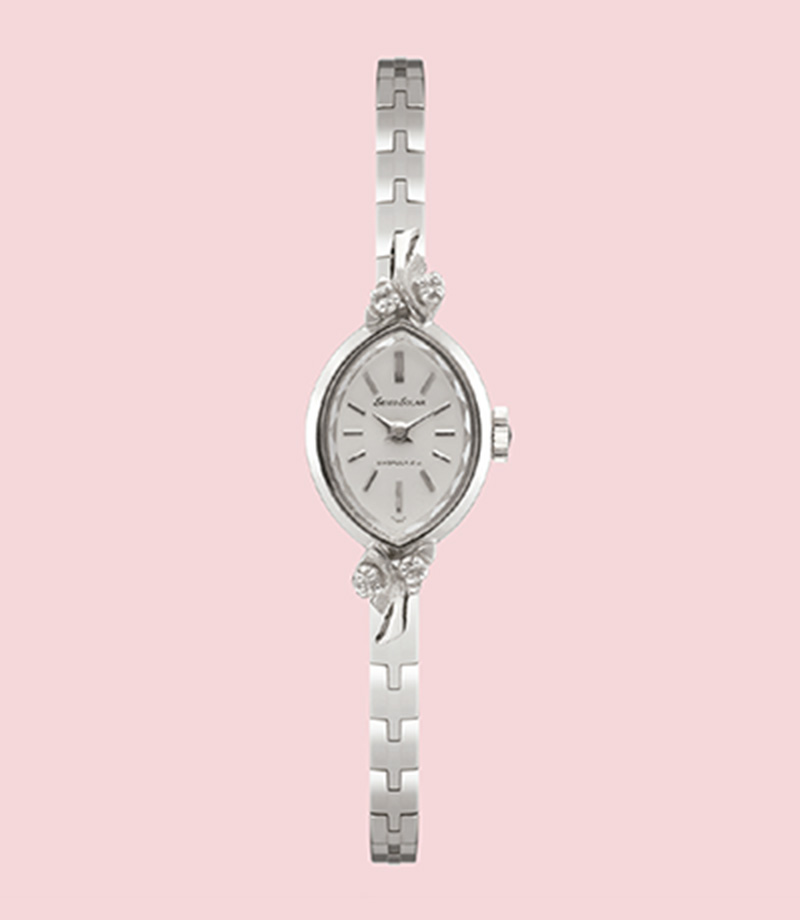
White
This watch was designed with a single, unified color (silvery white) for the case, dial, and bracelet. The delicate, almond-shaped case was its most distinctive feature, and was particularly popular in Japan and England.
43
LASSALE
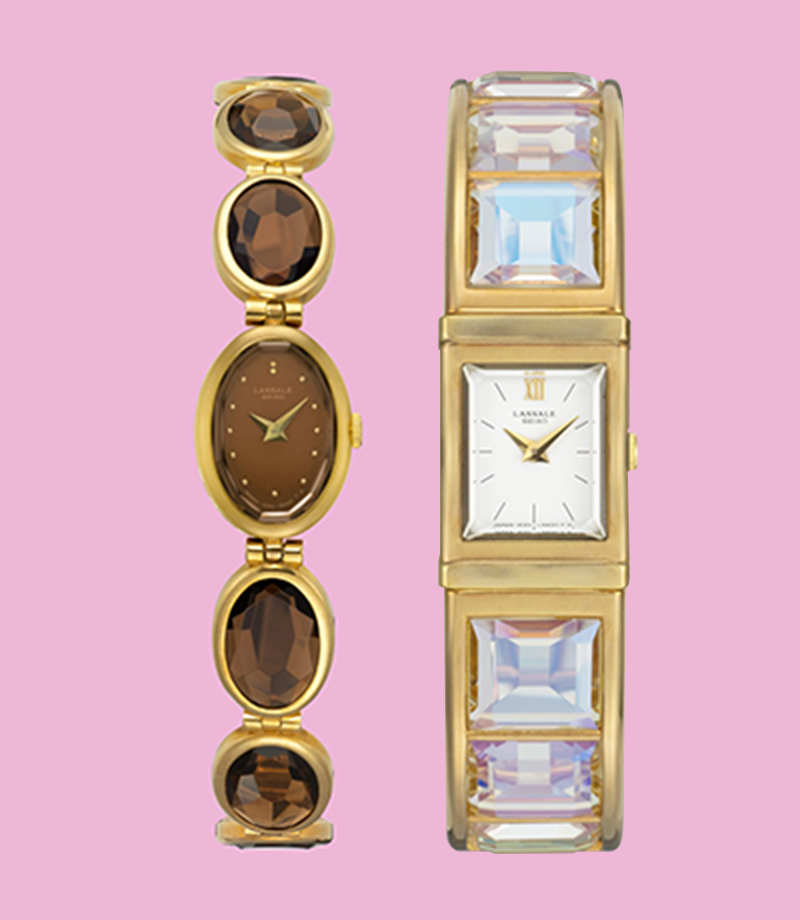
Lassale
Already popular overseas, the high-end Lassale line was later introduced in Japan as well. The mineral glass on the bracelet comes in an attractive variety of shapes and colors. Pictured here are ladies’ models from 1984.
44
TISSE
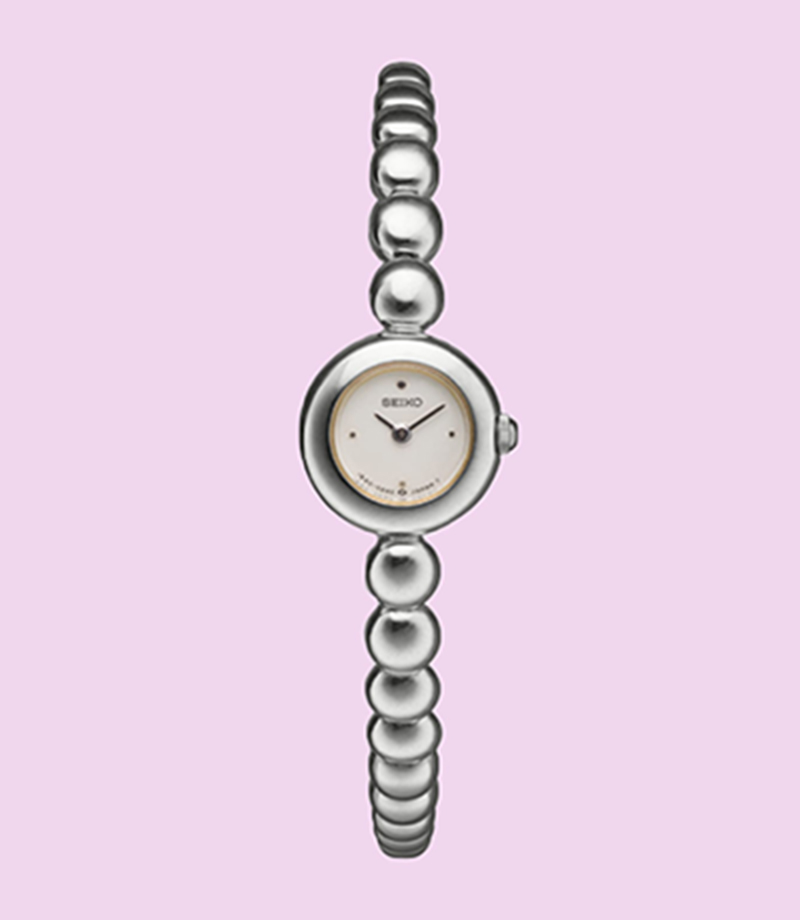
Tisse
As fashion sense evolved to include watches as accessories, it became necessary to make some models even more artistic and attractive. This model created a new style of loose-fitting watches with elegance derived from an extremely small movement.
45
NOIE
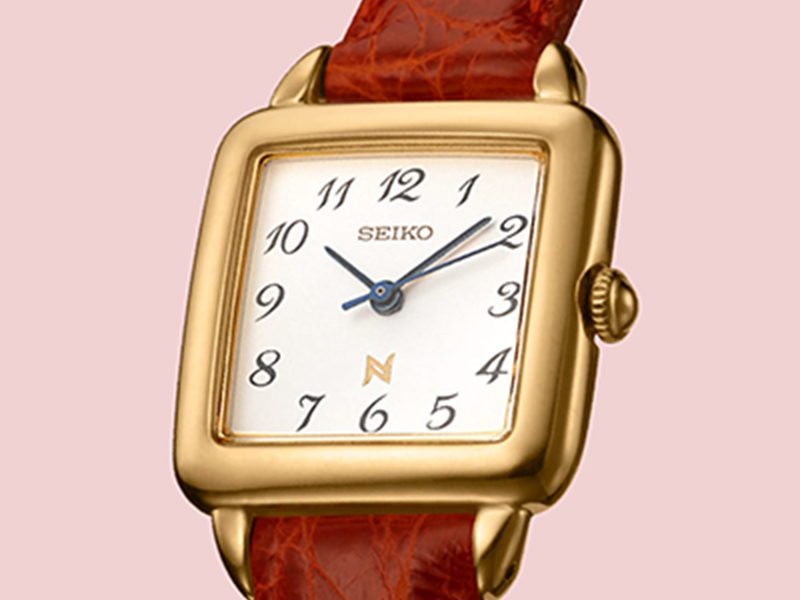
Noie
The graceful Noie had a softly rounded square case. This watch gained popularity due to the attention to detail in its design, including the use of original classic Arabic numerals and a brightly colored leather strap.
In the 1980s, Seiko was able to launch many more slim, decorative, accessory-type watches thanks to the development of extremely small quartz movements. Two good examples are the Lassale, with its characteristic colored-glass bracelet, and the Tisse, which highlighted a new style of loose-fitting watches. It was an era when mode fashion was on the rise. At a time when consumers were seeking bolder, more unique designs, Seiko launched the asymmetrical Rivoli, which was especially popular in Europe.
46
RIVOLI
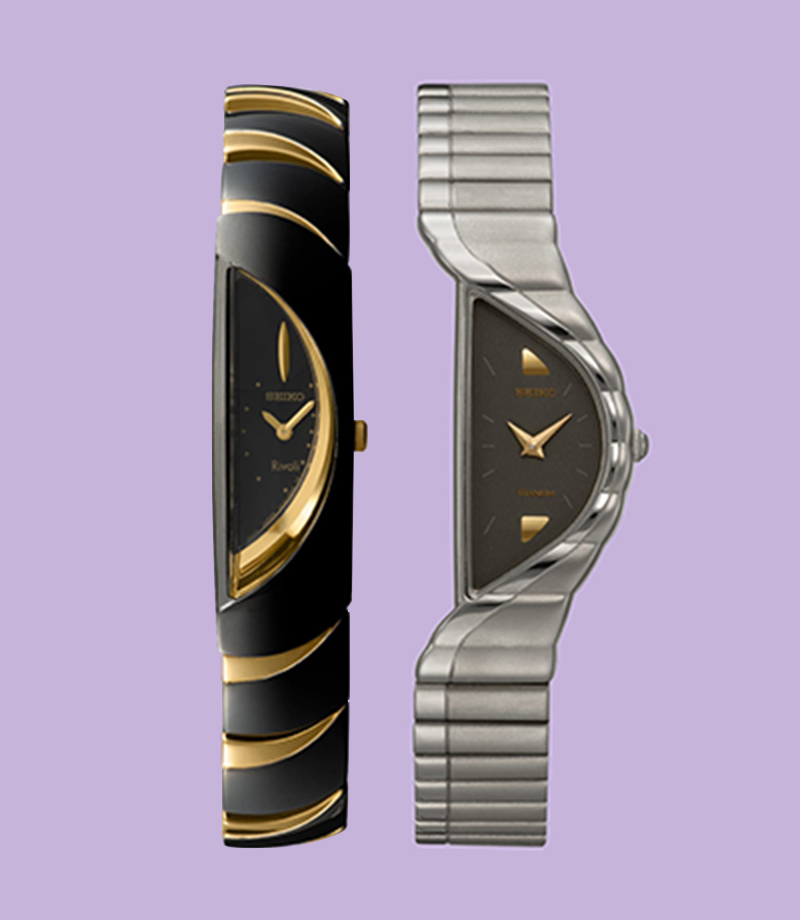
Rivoli
The Rivoli series, named after the Rue de Rivoli in Paris, was launched in the 1980s, just as fashion trends were changing. Its eye-catching, asymmetrical balanced design attracted a great deal of attention.
47
LUKIA
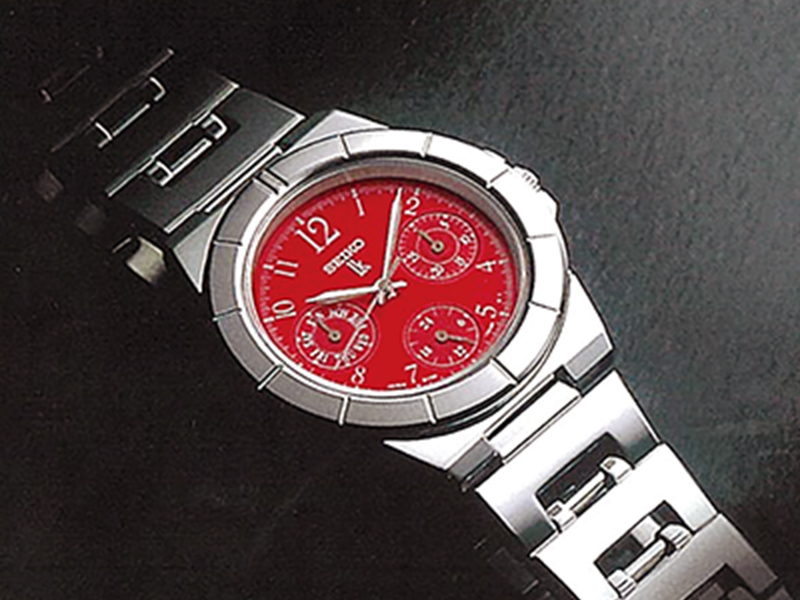
Lukia
This was the pioneer of Seiko's line of practical watches for independently minded women. Its reliable technology and aesthetically pleasing design have made it a very popular series.
Then, in 1995, the Lukia made its debut. This model had a feminine feel, high quality design, and excellent functionality, making it the perfect watch for working women.
Seiko has remained in tune with both changing lifestyles and fashion trends, always looking to create timepieces that match the aesthetic feelings of the times.
48
VIVACE
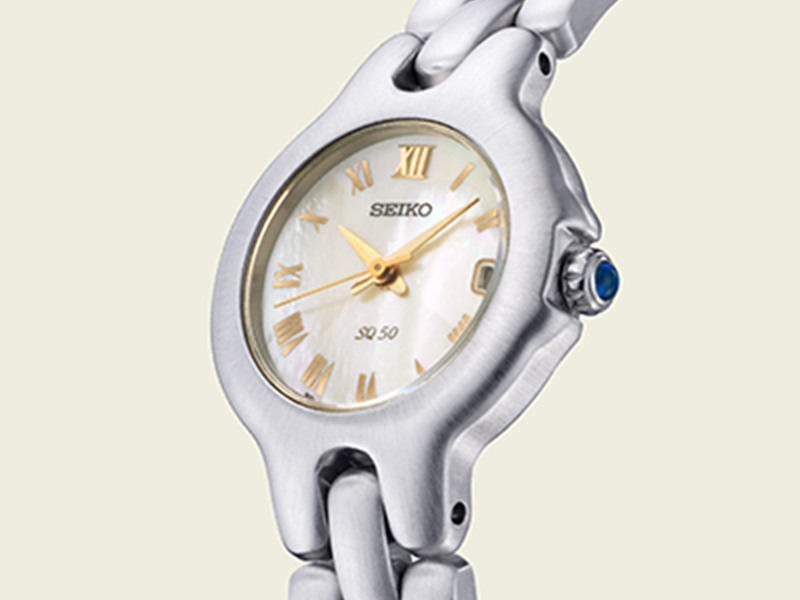
Vivace
The Vivace (Italian for “lively”) was developed for the international market, targeting active women in their 20s and 30s. The first model had a distinctively round, compact design, which became its signature.
49
SEIKO M
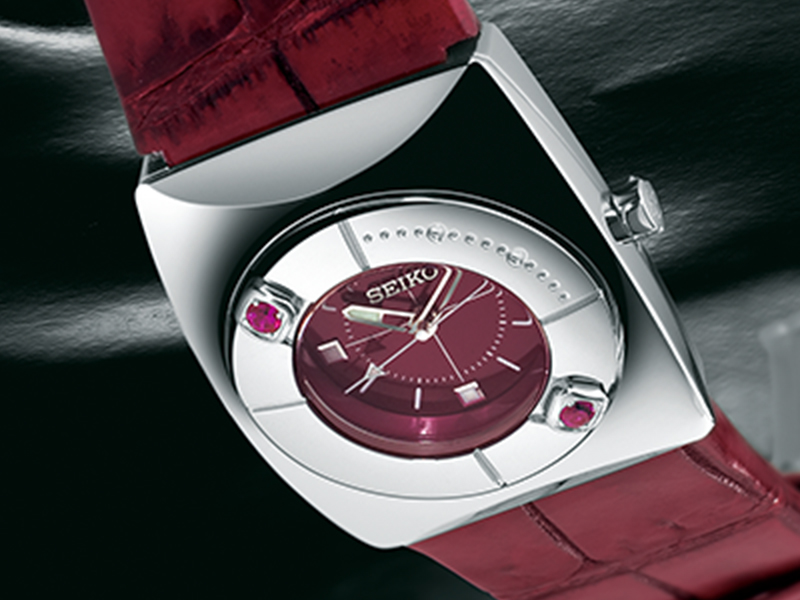
Seiko M
The stylish and sporty Seiko M invites women to join in or set off on their own adventures. A woman’s watch that brings together style and rugged construction, this series became a new fashion statement all its own.
The Beauty of Wabi-Sabi :
Traditional Japanese Craftsmanship
in Everyday Life
By fusing techniques stemming from traditional Japanese craftsmanship with cutting-edge modern technology, Seiko has produced both beautiful dress watches and gorgeous high-end luxury watches. Among these, the enamel dials adopted by the Laurel, the first domestically produced wristwatch, continue to be cherished for their classic beauty even in the contemporary models. The Presage Craftsmanship Series features dials made using traditional Japanese techniques, such as urushi lacquer, Arita porcelain, and Shippo enamel.
In 2023, the 110th anniversary of the Laurel, Seiko released four limited-edition models in its Craftsmanship Series. The unique dial materials, with alternating Roman numerals and indexes, reflect the high level of Japanese master craftsmanship. We value the comfort and classical feel that are rooted in Seiko's watchmaking history, with features such as a simple case structure that sits comfortably on the wrist.
The Beauty and
Mystery of Japan
The traditional Japanese performance art called kabuki derives from the word kabuku, meaning "to incline” or “to be unusual.” The name kabuki is said to derive from the fact that old-time kabuki actors wore cutting-edge fashions and novel or extravagant costumes in order to entertain the audience.
While Seiko has produced many watches with beautiful dials that incorporate traditional Japanese craftsmanship, it has also released models with avant-garde styling. Underlying this is a uniquely Japanese aesthetic sense and a tendency to incline away from the ordinary. For example, in 2009 Seiko for the first time released a new watch - the Seiko Ananta - simultaneously around the world, aiming it at the global luxury watch markets. Its design was based on the lines of a traditional Japanese sword, while the movement was powered by Seiko’s state-of-the-art Spring Drive mechanism. It was a beautiful chronograph style that could only be crafted in Japan.
54
Katana as
a Design Concept
In 2009, for the first time ever, Seiko simultaneously released a men’s watch series to global high-end watch markets. The design concept for this watch, the Seiko Ananta, was the katana, a traditional Japanese sword that transcended mere weaponry and became an expression of superb craftsmanship. The long and beautiful curvature connecting the case back to the lugs overtly resembles a katana blade, and combines with the Zaratsu-polished, distortion-free mirror surface to create the sense of a perfect, well-honed blade.
Seiko Ananta
Every part of this design projects the image of a Japanese sword. The model pictured here is powered by the Spring Drive Chronograph Caliber 5R86.
In a similar way, the multi-dial Kinetic Chronograph and bangle-shaped Seiko Spectrum also fused Japanese originality with cutting-edge technology. These models continue to be topics for watch fans worldwide, and are still seen as distinctly Japanese masterpieces.
Going forward, Seiko will continue to create watches that defy conventional concepts and express a sense of timeless Japanese aesthetics.
55
Unconventional
Multi-Dial Design
This was the first Kinetic Chronograph, which introduced a radical, multi-dial design that completely separated the time-display dial from the stopwatch dials. Kinetic was a proprietary Seiko mechanism that used the movement of the watch to automatically generate electricity to drive the quartz mechanism. Its high-tech feel perfectly matched the edgy, futuristic design, which became a hit with watch fans.
Kinetic Chronograph
This was the pinnacle of Seiko chronographs at the time, incorporating one function to instantly return the hands to zero, another to prevent errors in the seconds hand, and a structure to prevent the vaporization of the movement's lubricant oil.
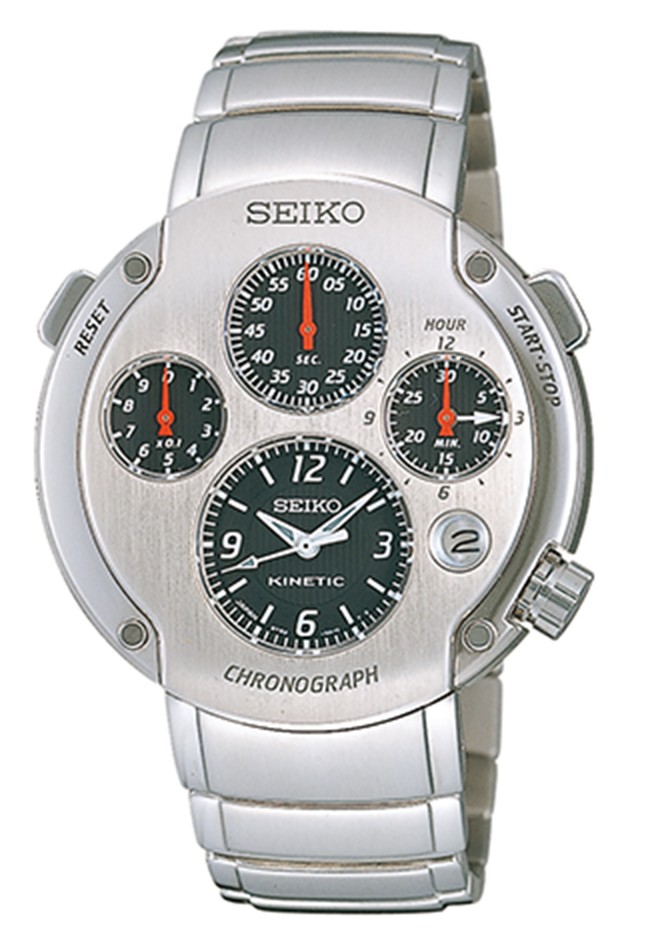
56
Bangle-Shaped
Display
The large, curved display took advantage of the most advanced electronic ink technology at the time. Seiko was one of the first companies to release a novel, bangle-style wristwatch featuring clearer contrast and a wider viewing angle than conventional LCD displays, as well as the freedom to bend the display.
The Seiko Spectrum was awarded Electronic Watch Prize at the 2006 Grand Prix d'Horlogerie de Geneve (GPHG).
Seiko Spectrum
This was the world’s first wristwatch to use microcapsule electronic ink technology, which enables displays to look more like graphic art. This futuristic design was praised as a completely new style of wristwatch.
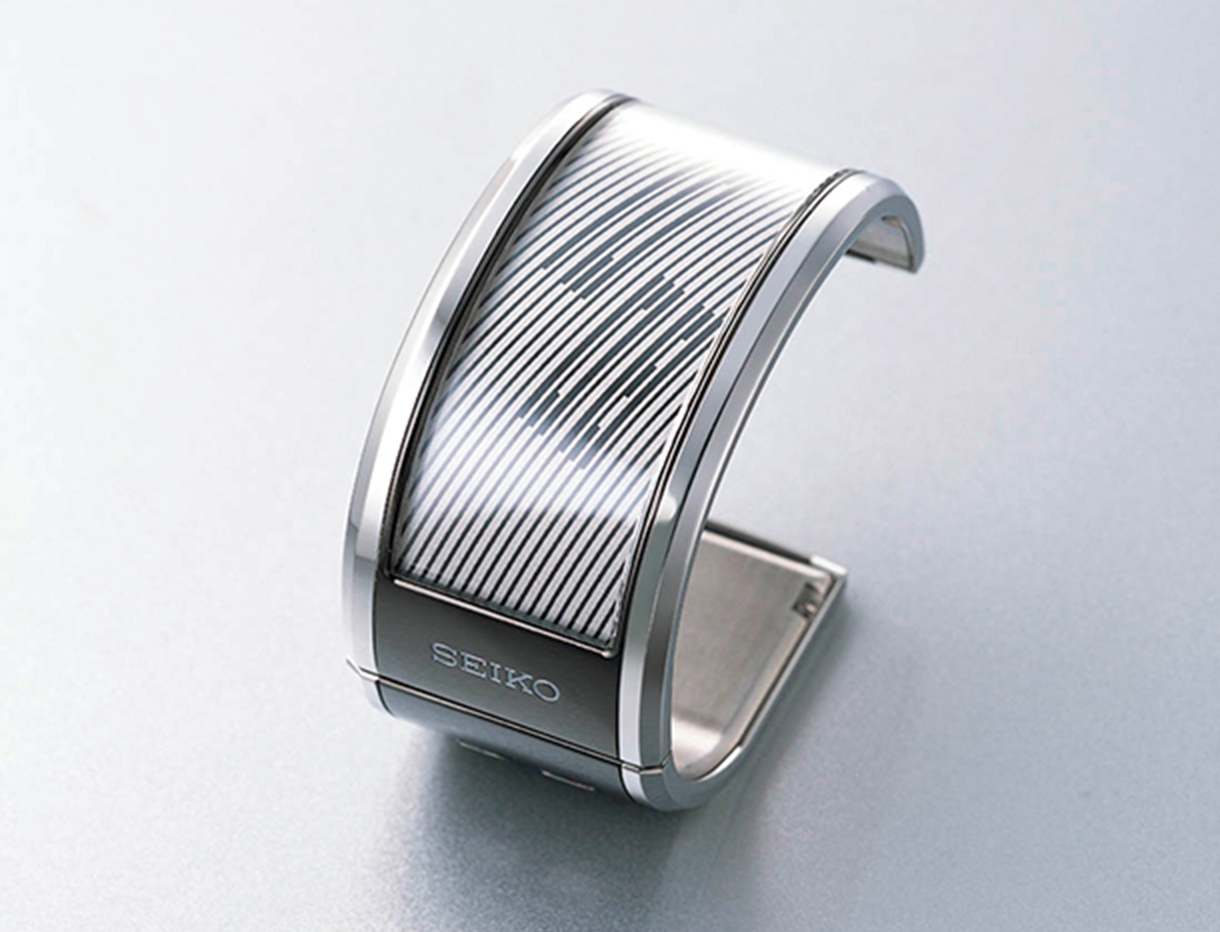
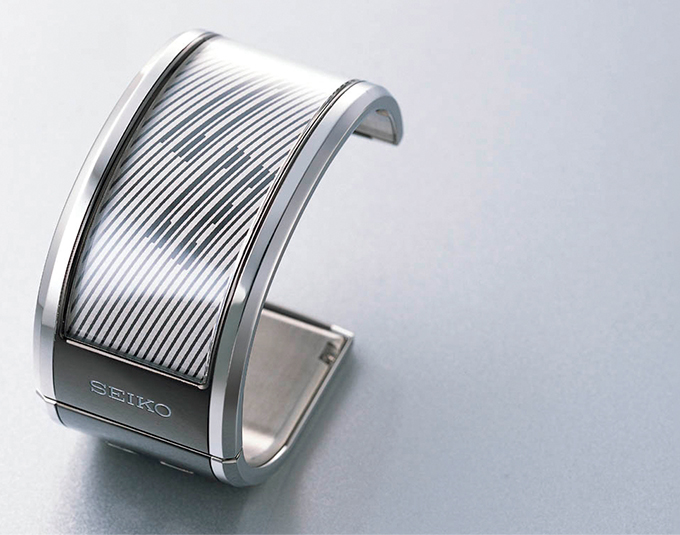
The more you know about the movement,
the more interesting a watch becomes!
There are very, very few watch companies that both develop and manufacture the intricate movements that form a watch’s heart. Seiko develops and manufactures all of its movements in-house, including all its mechanical, quartz and Spring Drive movements. Each movement contains highly advanced, proprietary technology. For example, Seiko pioneered quartz technology in 1969, and then, in 1999, created its another revolutionary mechanism, Spring Drive, which combines the advantages of mechanical and quartz. For traditional mechanical watches as well, Seiko is constantly developing and refining technology to improve both their precision and functionality.
The more you know about what is inside a watch, the more you will appreciate and enjoy wearing it.
60
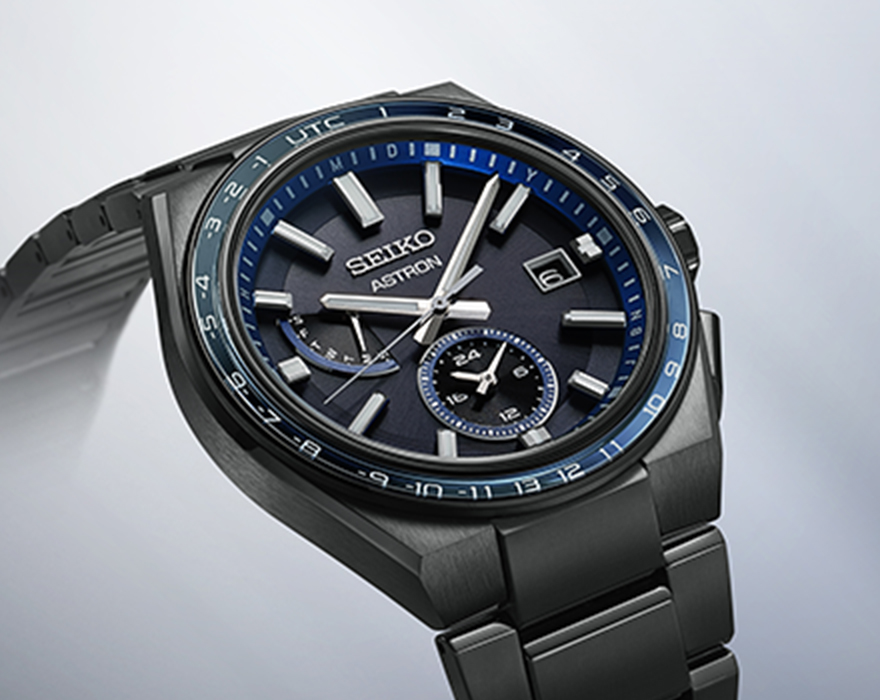
Solar Radio Wave
This solar-powered watch uses radio signals to automatically correct the time, achieving an accuracy of one second every 100,000 years. It is also equipped with a fully automatic calendar function until the year 2099.
61
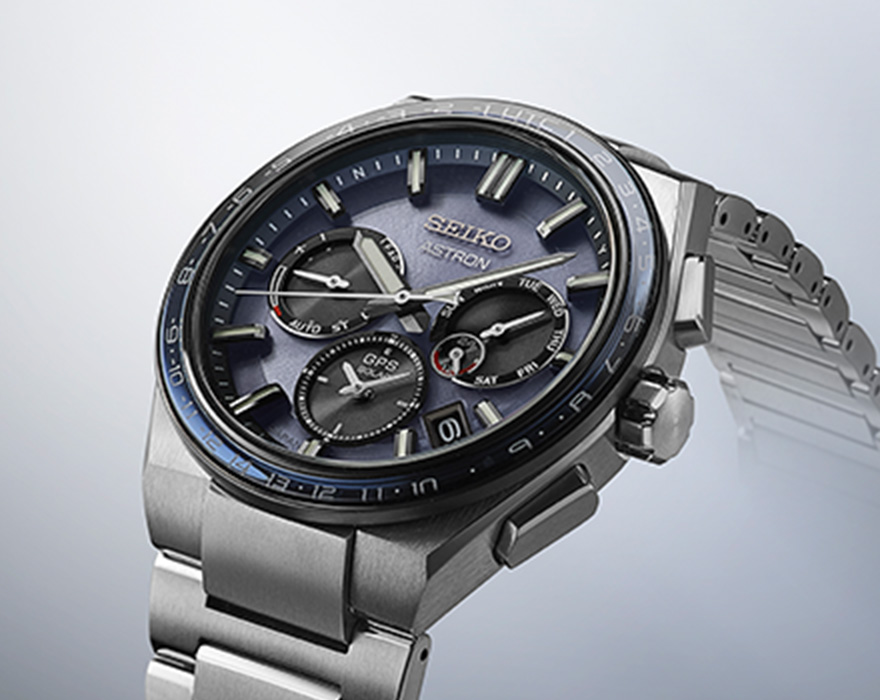
GPS Solar
This amazing watch locks onto signals from GPS satellites orbiting 20,000 km above the Earth to determine the user’s latitude, longitude, and altitude anywhere on the planet. It can then instantly display accurate time in any time zone worldwide.
Seiko Collections
Loved Worldwide
Some people may be surprised to see such unusual wristwatches. These models were mainly released by Seiko for international markets. Although the company already had a broad line-up of attractive watches, featuring a wide array of designs, Seiko decided to go one step further, constantly adding advanced functions and matching them with equally advanced styling.
Seiko released several popular sports watches, including for fans of motorsports and marine sports, decorated with vivid colors, as well as calendar models with a classical theme but modern functional beauty, and another with a futuristic design by a world-renowned watch designer. When we look at these watches even now, they feel new and fresh. All of these challenges helped to increase Seiko’s developmental capabilities, and substantially increased the brand’s fan base.
-
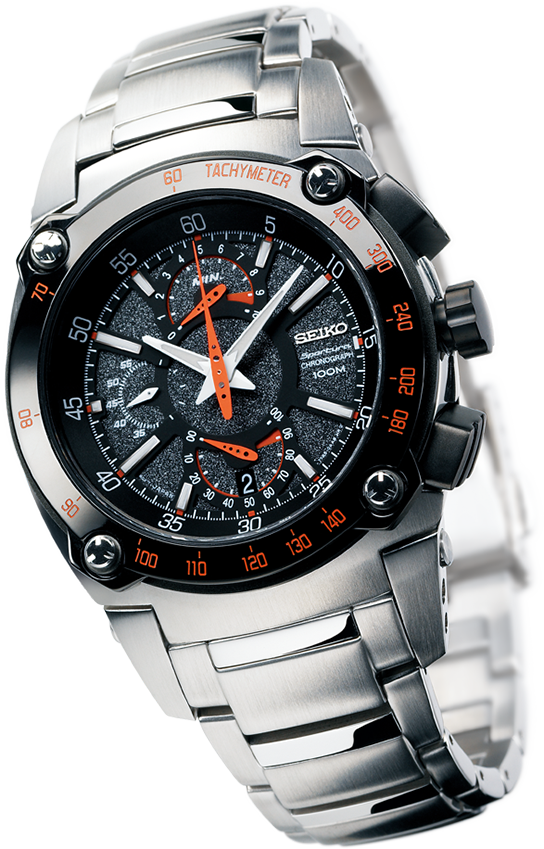
62
Sportura
For Hard Core Fans
of MotorsportsSportura coupled Seiko’s famous sports functions with motorsports-inspired styling. This series targeted hard-core fans of Formula 1 and other motorsports. Based on the All-Star Chronograph concept, this collection focused on chronograph models with advanced exteriors. The design, which embodied elements of speed, durability, and high functionality, became instantly popular.
-
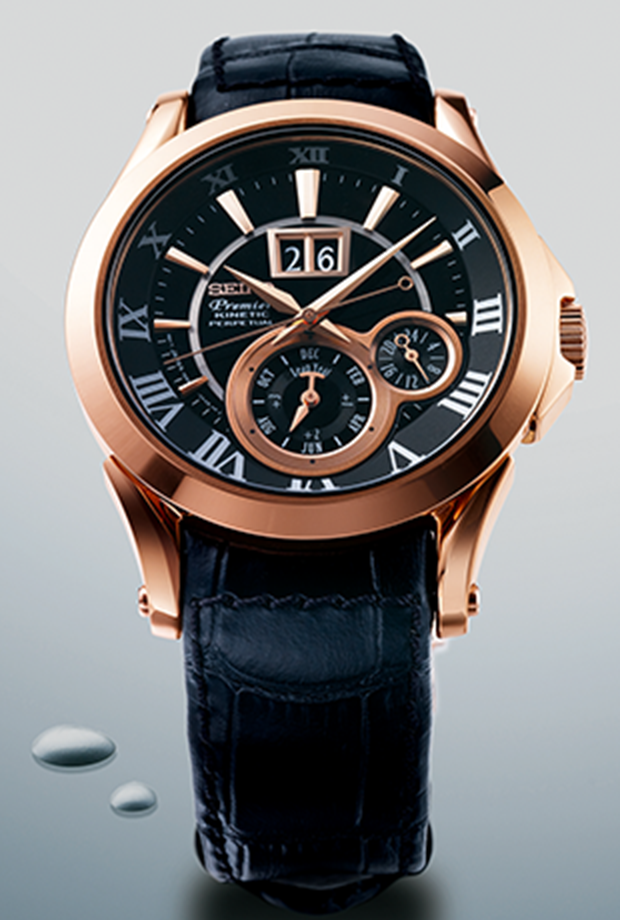
63
Seiko Premier
Classical Dress Watch
with a Modern FeelThe Seiko Premier collection imparts a modern feel to classical design elements. This series is aimed at fans of unique dress watches. It is known for the theme “Classic inspiration, Modern expression,” and the way this traditionally inspired design keeps evolving and modernizing. One of the collection’s most representative models, the Kinetic Perpetual, is pictured here. Note the big date and versatile calendar design, which were quite popular.
-
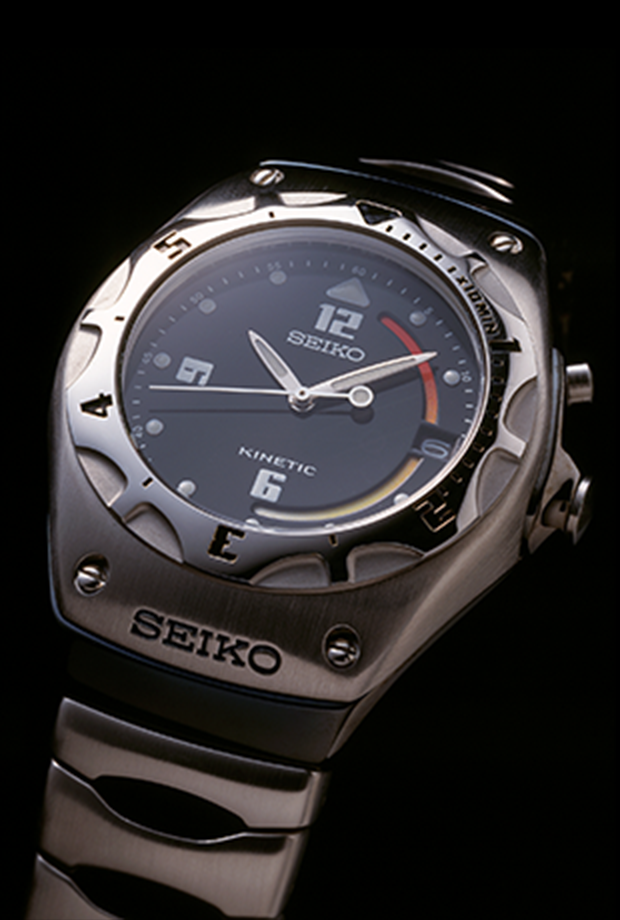
64
Arctura
A Futuristic Design for
an Innovative MovementArctura was a series that highlighted the originality of Seiko’s proprietary Kinetic movement, which generated electricity from the natural motion of the wearer’s arm. The design was known for its ergonomic styling and futuristic beauty, based on the concept of The Signature of KINETIC. Pictured here is the model released in 1999.
-
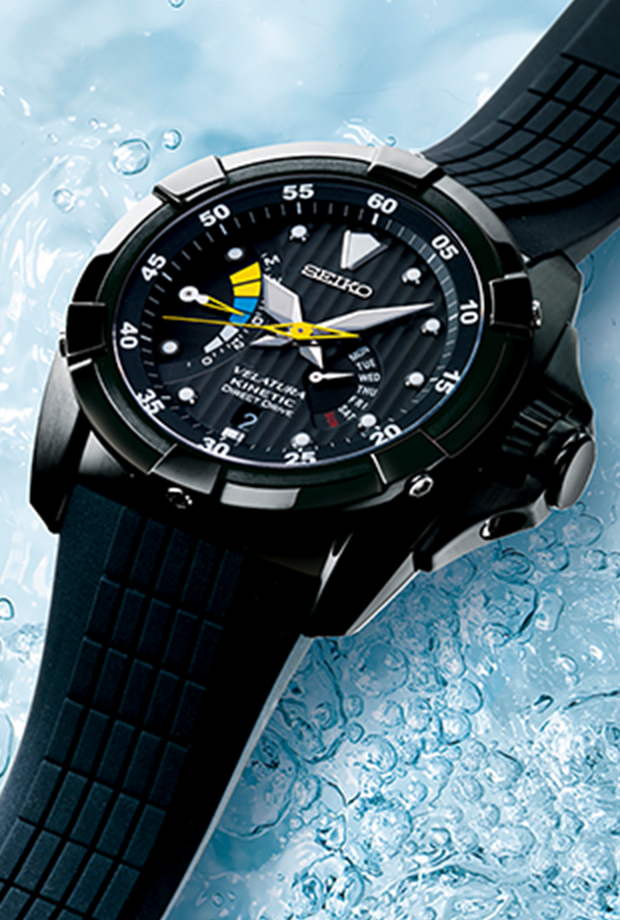
65
Velatura
A Powerful Aesthetic for
Active PeopleThe Velatura was aimed at meeting the latent needs of active individuals, such as marine sports enthusiasts who enjoy sailing and cruising. The 10-BAR water resistant Kinetic Direct Drive was especially popular. It was known for its interesting design, which placed a colorful power reserve indicator at the 9 o’clock position.
The Power of Design
Wristwatches are both tools for displaying the time and important accessories for eloquently conveying the wearers’ sense of style and even way of life. Seiko has long believed that, in addition to the essentials of legibility, wearability, durability, and operability, a watch should also have an inspirational design that lifts your mood just by wearing it. To achieve this, we have often collaborated with leading designers and artists. Many of these collaborations, such as those with GIUGIARO DESIGN, led by Mr. Giorgetto Giugiaro, one of the most influential automotive designers, produced masterpieces that are still cherished by watch fans today.
66
Creative Collaborations with Giugiaro
GIUGIARO
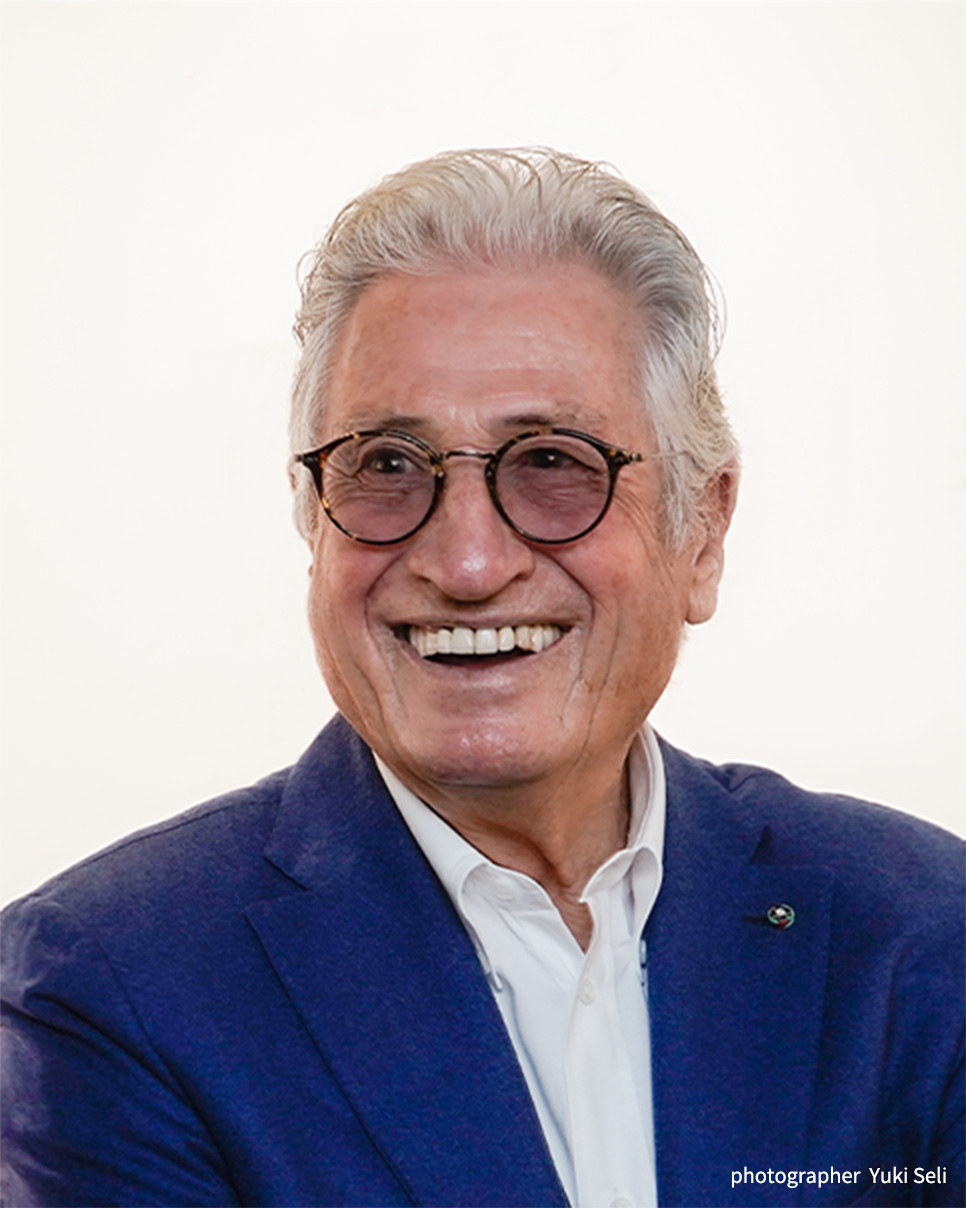
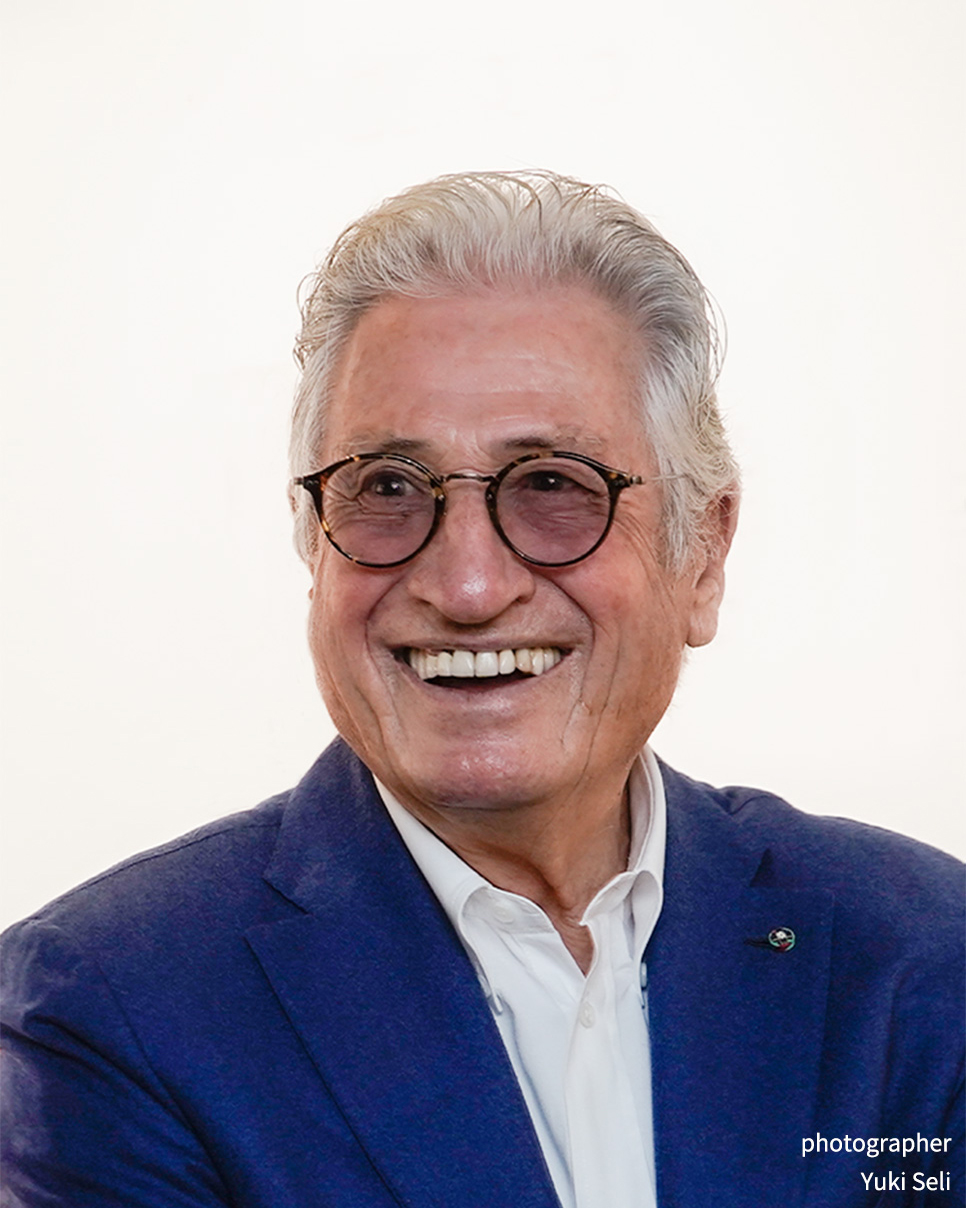
GIORGETTO GIUGIARO
Designer
GFG Style Chairman
Born in 1938 in Garessio, Cuneo, Piedmont, Mr. Giugiaro founded Italdesign in 1968 with Aldo Mantovani and designed more than 250 cars. He was also crowned Car Designer of the Century in 1999. Currently, he works as the Chairman of GFG Style, which was established in 2015 with his son, Mr. Fabrizio Giugiaro.
The first collaboration with Seiko was the 1983 Speedmaster collection. The common identity in all models of the Speedmaster collection was the fusion of outstanding practicality and, above all, a sporty philosophy that incorporated ergonomic principles.
Beauty, practicality, and ergonomics have always been my focus in the stylistic processes across various fields, from automobiles to industrial design objects.
The essence of my work has consistently been to collaborate on integrating form and feasibility, ergonomics, and usability. The accumulation of both small and large innovations is what has propelled Seiko to be a state-of-the-art watch company globally.
Congratulations on the 100th anniversary of the Seiko brand!
Giorgetto Giugiaro
67
SEIKO Power Design Project
From 2001, Seiko invited guest designer to spearhead the Seiko Power Design Project, in which Seiko employees themselves contemplated the future of the brand. Prototypes were exhibited to the public, and some of them became part of Seiko’s regular collections. Some models went on to win the Good Design Award from the Japan Institute of Design Promotion in 2007 for their commitment to creating new value for watches. Although this project ended in 2009, it was revived in 2022 as a new window to the future of watchmaking.
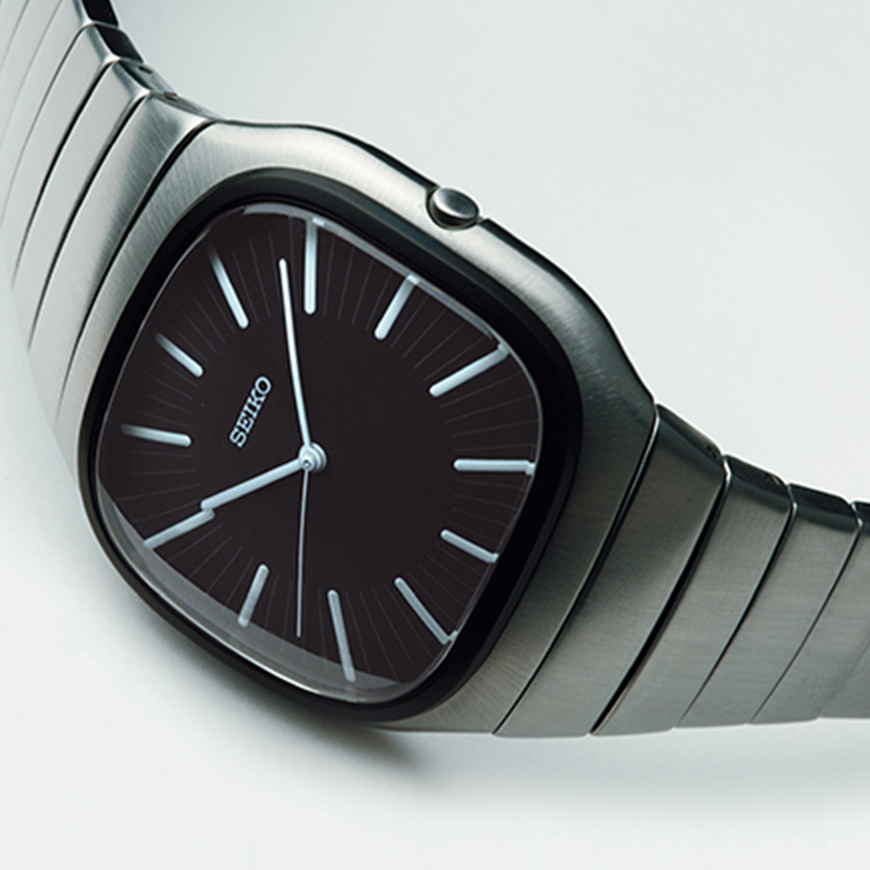
Experimental New Design Project
The Seiko Power Design Project takes a different theme each year, such as Mature Elegance and Refinement (2003), Fascination (2005) and TOKYO (2008). Seiko employees produced the prototypes, and a few of these designs became commercial models.
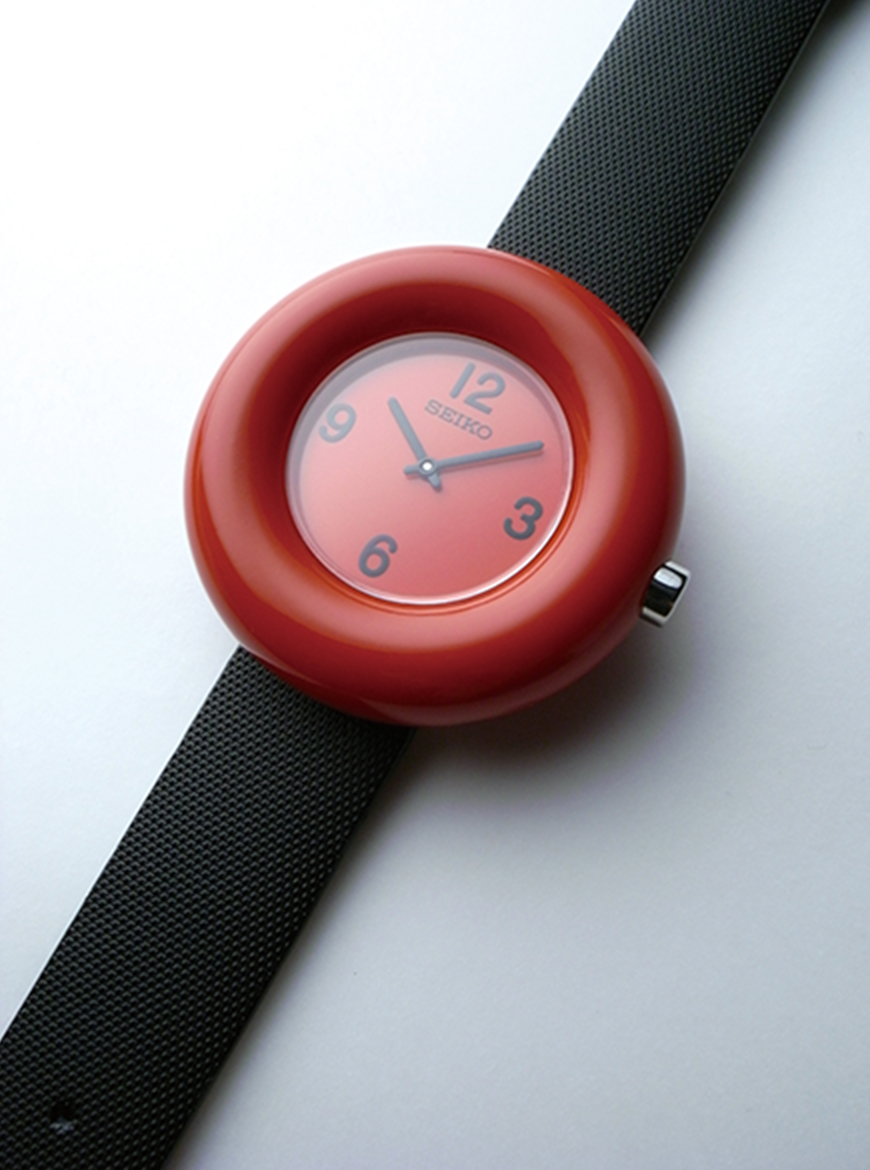
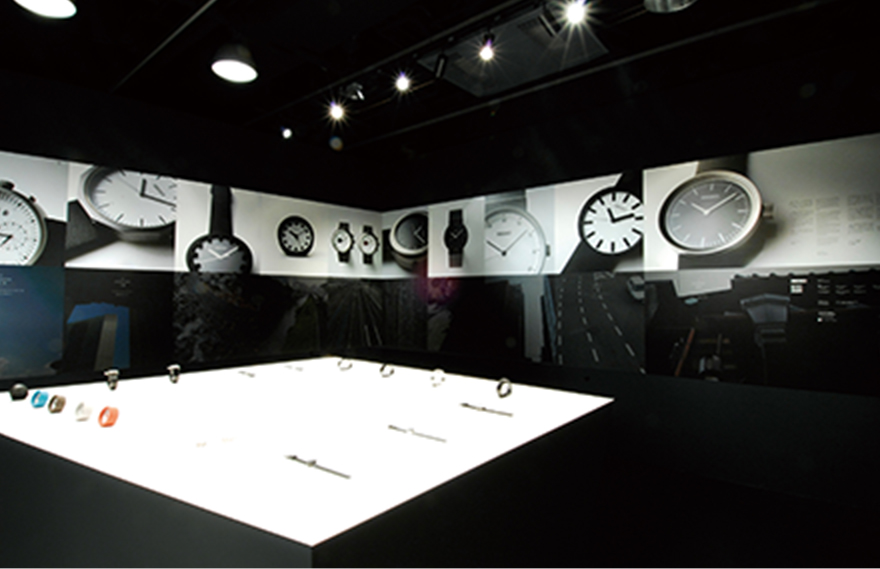
Exhibited Prototypes Propose the Future
Prototypes created for the Seiko Power Design Project were presented in an exhibition and shown to various media. These projects not only gained many new fans for the brand, but also became opportunities to expand the possibilities of our watch design.
